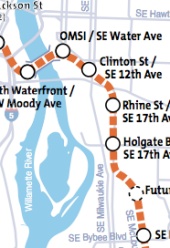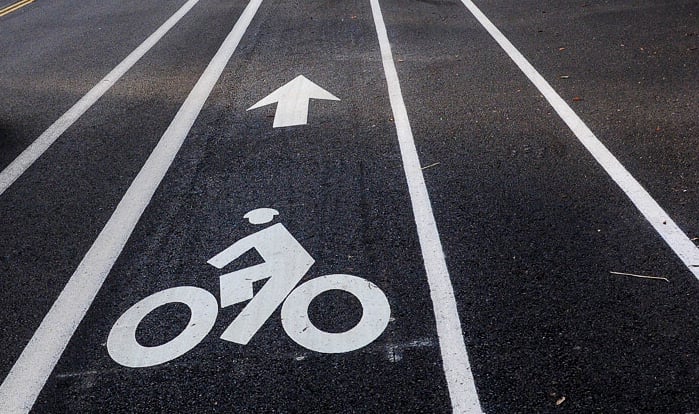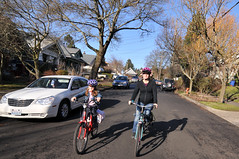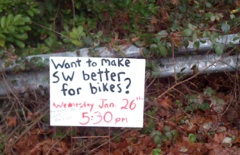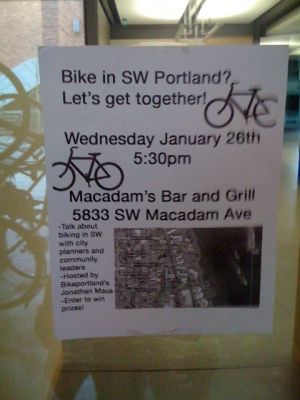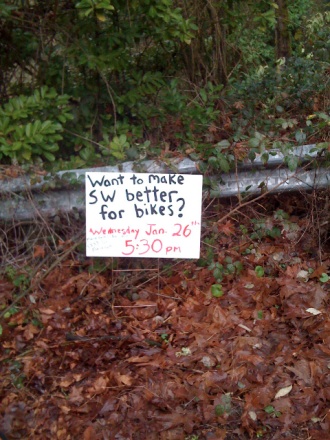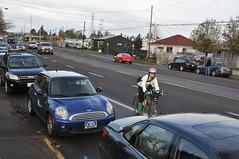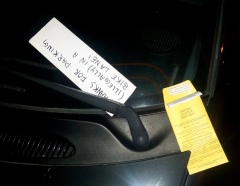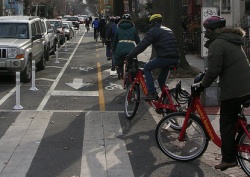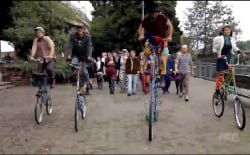I got the information below from well-known Southwest Portland neighborhood activist (especially on trail and transportation issues) Don Baack. I don’t have the time to make this into a Front Page story but wanted to spread the word because it’s important. Don wants everyone to know about an important meeting of SWTrails this Thursday (1/27). If you live, work, or ride in SW Portland, take a few minutes to read his note below and consider stopping by the meeting (and stay tuned for more coverage of this effort).
The regular meeting of SWTrails to be held on January 27th 7pm at St Luke Lutheran Church Conference Room 6835 SW 46th Avenue
The bulk of our next meeting will be devoted to discussing the strategy for Active Transportation in SW Portland.
Background: During the summer of 2009, Trails proposed the SW Active Transportation project which was focused on Barbur Blvd. The scope of this effort included improvements to Barbur and all the arterials linking to Barbur as well as the Red Electric. City staff prepared the application and submitted it to metro where it was considered along with 33 others.
In the fall of 2009, the Metro Study on High Capacity Transit was released. It identified the Barbur Corridor as a high priority. Metro then designated the corridor and appropriated funds for a large multiyear study of the Barbur I5 High Capacity Transit Corridor. When this happened, the staff of the Portland Bureau of Transportation, PBOT, decided that it would be unwise to invest in any further improvements on Barbur until the High Capacity Transit project was completed. That suggests a hiatus of 20 or more years.
Meanwhile, there will be an opportunity to propose pedestrian/bicycle transportation improvements in the next few months. SW Neighborhoods Board has has identified our top transportation priorities to be Capitol Highway, Barbur and the Red Electric Trail. All 3 have completed plans which have been approved by the Portland City Council. The segment of Capitol Highway from the south end of the Multnomah Overpass to Taylors Ferry Road received funding from federal dollars to do the detail plans leading to letting contracts for the work. The one mile segment will cost 19.6 million dollars. To date, the funds for completing the job have not been allocated. This will provide sidewalk and bike lanes on each side of the street. About 51% of the costs are storm water related. Two other segments of Capitol Highway remain to be addressed, east of Hillsdale from SW Cheltenham to Terwilliger, and the “Hoot Owl Corner” at sw 30th and Vermont/Capitol Highway. No funding has been secured or dedicated to these segments to date.
Barbur has had 3 or 4 crosswalks and one signal installed since 1999 when the Barbur Streetscape Plan was completed and adopted. Additional sidewalks along Barbur were constructed fall of 2010 as part of the federal stimulus program.
The Red Electric Plan was completed and approved by Portland City Council. Since its approval, federal funds have been secured to construct a bridge from Capitol Highway to SW Bertha (west) across a very deep gully on Fanno Creek. The bridge is currently in design. Efforts are underway to secure segments of rights of way for the westerly part of the Red Electric from SW 33rd to the Multnomah County line. SWTrails, the Hillsdale Neighborhood, and the South Portland neighborhood have actively sought to gain Parks Bureau and PBOT support for funding of the eastern end of the Red Electric which will include a new Barbur Ped/Bike bridge beside the existing Barbur Blvd Newbury Structure, just south of Capitol Highway’s connection to Barbur near Hillsdale, since the integrated wood concrete design of the Newbury Structure will not permit the existing bridge to be widened. To date, the city staff have not chosen to support our effort.
In 2009 the Oregon State Legislature passed a new gas tax bill which began collecting additional taxes this summer. In response to the additional revenue from this bill, an estimted 8 million dollars give or take a couple million, was allocated to sidewalks for SW Portland. A long effort was undertaken to decide on the priority locations in SW Portland where it should be spent. Those location were segments of SW Huber, SW Multnomah Blvd, SW Vermont, SW Sunset and one other.
Now we in SW are faced with deciding what federally funded projects should be our top priority. That will be the focus of our meeting ont the 27th.
If we assumed that this round all our funding requests be directed to our prior top priortiy projects, then we should look at Barbur, Capitol Highway and the Red Electric.
In my view, this is a very important moment in the future of Active Transportation in SW Portland. By any measure except safety, Barbur Blvd is the best bicycle route from 90% of SW Portland to Downtown Portland, from Tigard to Portland and from Lake Oswego to Portland. We clearly have major safety problems for both pedestrians and bicyclists along Barbur Blvd. Barbujr is a regionally significant route for motor vehicles and for bicyclists. If we look at the bridge of Barbur from the north to the south, we can see that the improvment of the Newbury structure is first in importance. Once Newbury is solved, that opens up the connection to the Red Electric and makes Slavin Road a key link to the Pedestrian Bridge, the growing employment area in the south waterfront and a an off street alternative route to downtown via the soon to be built greenway trail along the river. It will also be a much more comfortable ride for the less bold bicycle rider to reach all of these destination. The Red Electric connection will enable riders from Bridlemile, Hillsdale, Multnomah, Hayhurst and Maplewood to follow Vermont, the Red Electric, Beaverton Hillsdale Highway and Hamilton/Sunset to safely ride down downtown and back.
If we then follow this new stand alone bridge with another one at crossing the Vermont gully, a longer and more expensive span, it opens up a much wider vista of bicylce sheds: Terwilliger, Boones Ferry Road, the western part of Lake Oswego, 19th and Multnomah Blvd. All of these could then travel to downtown on a much safer route. These two bridge improvements could then be followed in order by Multnomah and the other bridges west of Multnomah. The key is not to let the City of Portland decide that we will not be able to invest in Active Transportation Improvements on Barbur until Light Rail is installed and running. That could be as long as 20 or 30 years depending on the whims of Congress and the President and thier idea of transportation priorities.
It is my view we should be very aggressive in setting forth what we feel we need in the way of an Active Transportation network and work to make it happen.
The first step, again in my opinion, is the funding of the 3.77 million dollar pedestrian/bicycle bridge adjacent to the existing Newbury structure along with the connections to the street on the west, and to the end of Slavin Road on the east.
Subsequent steps will be the funding of the other bridges along Barbur to make the entire route from Tigard to Downtown Portland safer for bicyclists. There are also a number of other projects which should be addressed when funding is available, especially in the areas where there are neither sidewalks or bike lanes.
That is not intented to suggest that the other candidates for improvements are not warranted, but I feel we must be strategic in our choices and not fritter away whatever funds are available on projects that affect a smaller part of SW Portland. .
The following are links to important documents relating to the above discussion:
— The ODOT spreadsheet on costs of the bridge improvement 2009 (PDF)
— Newbury structure drawing and connection to the Red Electric Trail coming from SW Parkhill Drive (JPG)
